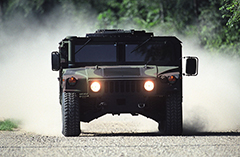1. The Active Denial System:
The Active Denial System (ADS) is a non-lethal, directed-energy weapon developed by the U.S. military, designed for area denial, perimeter security and crowd control. Informally, the weapon is also called the heat ray since it works by heating the surface of targets, such as the skin of targeted human subjects. Raytheon is currently marketing a reduced-range version of this technology. The ADS was deployed in 2010 with the United States military in the Afghanistan War, but was withdrawn without seeing combat. On August 20, 2010, the Los Angeles Sheriff's Department announced its intent to use this technology on prisoners in the Pitchess Detention Center in Los Angeles. More details
2. The Shadow Hybrid Electric Vehicle:
3. Humvee and Hummer:
4. Heavy Expanded Mobility Tactical Truck:
5. Jeep History:
6. Directed Energy Weapons:
An armoured vehicle-launched bridge (AVLB) is a combat support vehicle, sometimes regarded as a subtype of military engineering vehicle, designed to assist militaries in rapidly deploying tanks and other armoured fighting vehicles across gap-type obstacles, such as rivers. The AVLB is usually a tracked vehicle converted from a tank chassis to carry a folding metal bridge instead of weapons. The AVLB's job is to allow armoured or infantry units to cross craters, anti-tank ditches, blown bridges, railroad cuts, canals, rivers and ravines), when a river too deep for vehicles to wade through is reached, and no bridge is conveniently located. More details
A modern torpedo is a self-propelled weapon with an explosive warhead, launched above or below the water surface, propelled underwater towards a target, and designed to detonate either on contact with its target or in proximity to it. Historically, it was called an automotive, automobile, locomotive or fish torpedo; colloquially called a fish. The term torpedo was originally employed for a variety of devices, most of which would today be called mines. From about 1900, torpedo has been used strictly to designate an underwater self-propelled weapon. More details
Radar is a detection system that uses radio waves to determine the range, angle, or velocity of objects. It can be used to detect aircraft, ships, spacecraft, guided missiles, motor vehicles, weather formations, and terrain. A radar system consists of a transmitter producing electromagnetic waves in the radio or microwaves domain, a transmitting antenna, a receiving antenna (often the same antenna is used for transmitting and receiving) and a receiver and processor to determine properties of the object(s). Radio waves (pulsed or continuous) from the transmitter reflect off the object and return to the receiver, giving information about the object's location and speed. More details
10. Spy Satellites:
A spy satellite (reconnaissance satellite) is an Earth observation satellite or communications satellite deployed for military or intelligence applications. The first generation type (i.e., Corona and Zenit) took photographs, then ejected canisters of photographic film which would descend back down into Earth's atmosphere. Corona capsules were retrieved in mid-air as they floated down on parachutes. Later, spacecraft had digital imaging systems and downloaded the images via encrypted radio links. In the United States, most information available is on programs that existed up to 1972, as this information has been declassified due to its age. More details
11. Stealth Technology:
Stealth technology, also termed low observable technology (LO technology), is a sub-discipline of military tactics and passive and active electronic countermeasures, which covers a range of methods used to make personnel, aircraft, ships, submarines, missiles, satellites, and ground vehicles less visible (ideally invisible) to radar, infrared, sonar and other detection methods. It corresponds to military camouflage for these parts of the electromagnetic spectrum (i.e., multi-spectral camouflage). Development of modern stealth technologies in the United States began in 1958, where earlier attempts to prevent radar tracking of its U-2 spy planes during the Cold War by the Soviet Union had been unsuccessful. More details
12. Bradley Fighting Vehicle:
The Bradley Fighting Vehicle (BFV) is a fighting vehicle platform of the United States manufactured by BAE Systems Land & Armaments, formerly United Defense. It was named after U.S. General Omar Bradley. The Bradley is designed to transport infantry or scouts with armor protection, while providing covering fire to suppress enemy troops and armored vehicles. The several Bradley variants include the M2 Bradley infantry fighting vehicle and the M3 Bradley cavalry fighting vehicle. The M2 holds a crew of three (a commander, a gunner, and a driver) along with six fully equipped soldiers. More details
The Bradley Fighting Vehicle (BFV) is a fighting vehicle platform of the United States manufactured by BAE Systems Land & Armaments, formerly United Defense. It was named after U.S. General Omar Bradley. The Bradley is designed to transport infantry or scouts with armor protection, while providing covering fire to suppress enemy troops and armored vehicles. The several Bradley variants include the M2 Bradley infantry fighting vehicle and the M3 Bradley cavalry fighting vehicle. The M2 holds a crew of three (a commander, a gunner, and a driver) along with six fully equipped soldiers. More details
13. Boeing YAL-1 Airborne Laser:
The Boeing YAL-1 Airborne Laser Testbed (formerly Airborne Laser) weapons system was a megawatt-class chemical oxygen iodine laser (COIL) mounted inside a modified Boeing 747-400F. It was primarily designed as a missile defense system to destroy tactical ballistic missiles (TBMs) while in boost phase. The aircraft was designated YAL-1A in 2004 by the U.S. Department of Defense. The YAL-1 with a low-power laser was test-fired in flight at an airborne target in 2007. A high-energy laser was used to intercept a test target in January 2010, and the following month, successfully destroyed two test missiles. Funding for the program was cut in 2010 and the program was canceled in December 2011. More details













